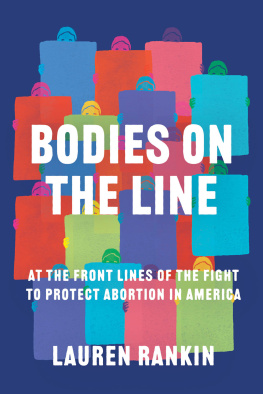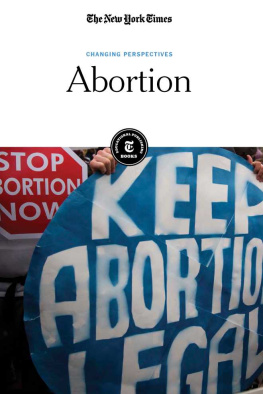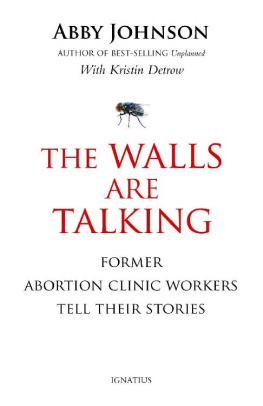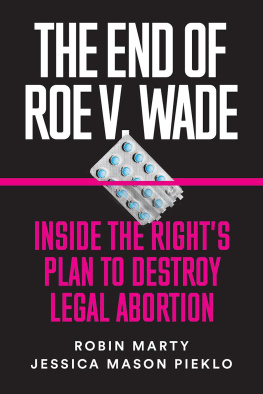Table of Contents
Guide
BODIES on the LINE
BODIES on the LINE
At the Front Lines of the Fight
to Protect Abortion in America
LAUREN RANKIN
COUNTERPOINT
BERKELEY, CALIFORNIA
For Drew and Elodie
I stand up, and this one of me
turns into a hundred of me.
They say I circle around you.
Nonsense. I circle around me.
Rumi
Contents
BODIES on the LINE
Y OU CANNOT BLOCK THE CAR , I TOLD THE BODIES AMASSED in front of the cab. That is against the law!
We dont have to listen to you! a man yelled back as he elbowed past me. Youre not better than us!
By that bright August morning in 2015, it had been more than a year and a half since I began volunteering as a clinic escort at Metropolitan Medical Associates clinic in northern New Jersey. I had no idea what a clinic escort was when I started, much less why it was necessary. I didnt really know that abortion clinics still experienced aggression and hostility, that dozens of picketers showed up on any given day to yell at anyone who walked into a clinic. And I certainly didnt understand how important clinic escorts were in supporting patients and making abortion access a reality. I would quickly learn.
I turned my attention back to the cab. This Saturday morning started like mosta handful of agitators buzzing aroundbut by the time that cab pulled up, dozens of angry protesters had filled the sidewalk outside the clinic, and they were amped up. Now they had completely blocked the rear doors of the cab, shoving their signs into the windows and screaming at the people sitting in the back seat. It was impossible for anyone to get in or out of that cab.
I felt anger rising in my gut, panic building in my toes. I wanted to scream at them, push them out of the way. But I couldnt. I knew that wouldnt help. Stay calm, I told myself. You cant afford to lose control. Just find a way to get to that back seat.
My bright yellow vest, with the words CLINIC ESCORT VOLUNTEER printed across the chest, did absolutely nothing to encourage this mass of antiabortion protesters to clear the way for whoever was seated in the back. It was my job to get to them, to help them out of the car, to support them and walk them past this hostile group. I was a clinic escort. I was supposed to be their lifeline, their support. I put my body on the line for theirs.
But in that moment, there was no way for me to get to the cab without physically moving bodies, and I wasnt allowed to do that. My clinic escort team practiced strict nonengagement, which meant that we couldnt even speak to the protesters, let alone touch them. Even if they elbowed or shoved one of us (and they certainly did), we couldnt reciprocate. There was only one thing left for me to do. I held the walkie-talkie close to my lips. Security, I need you, I said. Now.
As the security guard barreled through the front door toward us, I glanced from left to right, trying to keep tabs on the additional protesters that orbited the mob. I doubt anyone wants to go to jail today, the guard muttered. Just like that, the mob dispersed, parting like the Red Sea. He poked his head in the back seat, beckoning whoever was in there to come on out. Another clinic escort and I were beside him. As soon as the woman emerged, I wrapped my arm around her. I pivoted my body, a stranger tucked into my left side, and used my right arm to create a barrier between her and the protesters, who were desperately trying to get in her face. I took a step and so did she, in tandem, one after the other.
It was just the two of us, together, in that moment. The mass of bodies through which I navigated our two bodies, the cacophony around usDont murder your baby! No mate a su hijo! Youll still be the mother, just the mother of a dead baby!faded into the background as I narrowed my focus to a singular goal: get her in the door.
Its all going to be okay, I said in a low, soothing tone. Keep listening to my voice. The door is right over there. Were so close, just stay with me and stay with my voice. Everything is going to be all right.
It took the blink of an eye, or a lifetime, to reach that door.
The door closed behind us, and we were suddenly enveloped in silence. I finally lookedreally lookedat who I had just escorted. Her baby face was frozen in fear, her hands clenched in tiny, defensive fists. This wasnt a woman at all. This was just a girl, and she was absolutely terrified.
Its over now, I said. Youre inside. Youre safe.
She collapsed into me, heaving, releasing guttural sobs into my chest. I held her, slowly rocking her back and forth. The security guard moved back behind the plexiglass barrier to his seat.
Its okay, I repeated. Its all going to be okay. Youre inside. They cant get you in here. Youre safe. Its okay.
We rocked, back and forth, back and forth, for another minute. Or another hour.
The front door opened. Another woman shuffled in, flanked by my fellow clinic escort. The girl in my arms looked up, recognizing her mother, and started sobbing again. Her mother held her, checked her in to the clinic, and walked into the waiting room. She was in. She was going to be okay.
I took a breath, gently chewing the side of my cheek as the adrenaline started to wane.
You okay? the security guard asked.
Yeah, Im fine. I wasnt, really, but I didnt have any other choice. There were more patients coming, more people to walk through the gauntlet. I opened the clinics front door, slamming it against the outer brick wall. I stared at the group of protesters, meeting their hostile gaze with an inner fire that, until that moment, I didnt know I had.
Im calling the cops on the next person to try something like that, I wanted to scream at them. I wanted to tell them how cruel they were, how despicable their behavior was, how furious it made me to see what they did to that young girl whose tears now stained my vest.
Instead, I walked over to the next car. It started anew.

On May 17, 2021, the Supreme Court announced that it would hear oral arguments in Dobbs v. Jackson Womens Health, a challenge to Mississippis ban on abortions at fifteen weeks. Nearly fifty years after legalizing abortion nationwide through its landmark 1973 ruling, Roe v. Wade, the Court is now poised to potentially end it.
Today, most people of reproductive age in the United States were born post-Roe (myself included), in a world where legal abortion was a given. That right had already been fought for and won, we were raised to think. If you ever needed an abortion, you could just go to a clinic and get one, right?
Now, nearly half a century later, faced with the very real possibility that Roe v. Wade might in fact be overturned, we are left to reckon with what once seemed so unthinkable. How did we get here? Could abortion really become illegal? How, in 2022, are we facing a post-Roe America?
It has happened slowly, under our noses, for decades. For just as long as there has been legal abortion in the United States, there has been a dedicated and concerted effort to undermine it. The crisis point at which Roe v. Wade now finds itself is the result of years of restrictions and bans, yes, but also a coordinated effort to if not outright ban abortion, then make it as difficult to get as humanly possible.
Nowhere is that clearer than outside the front door of an abortion clinic.
If you live in one of the 10 percent of U.S. counties that still has an abortion clinic, there is probably a group of picketers outside of it right now. They might be holding gruesome signs with doctored photos of bloody fetuses. Some might be yelling into megaphones, accosting every person who walks by the clinic. Others are probably holding up their cell phones, capturing patients faces as they enter the clinics doors, posting them online when they get home. Theyre swarming patients cars. Then theyre slamming their signs into car windows. And theyre shouting, Dont murder your baby! in a girls face. For blocks, they follow people. Youre going to hell, they shout. Youre going to die inside that butcher shop! They pray and prey, over and over again.










